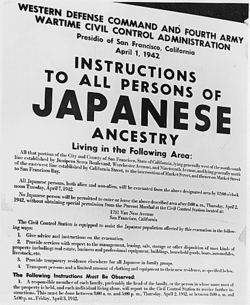Executive Order 9066

Executive Order 9066 was a presidential executive order. It was signed and issued during World War II by the President of the United States Franklin D. Roosevelt on February 19, 1942, authorizing the Secretary of War to prescribe certain areas as military zones. The order cleared the way for the deportation of Japanese Americans to internment camps. As a result, tens of thousands of Japanese Americans and Japanese nationals were interned during the war.[1] The same order was also applied to numbers of American residents of Italian or German descent.
Background[change | change source]
After the Japanese attack on Pearl Harbor, the United States was very suddenly at war.[2] Fear, outrage and hatred of the Japanese over the surprise attack was aimed at the Japanese Americans living in the U.S.[2] It became a common belief that the amount of destruction, including most of the U.S. Naval fleet, was because Japanese Americans helped plan the attack. There was also the immediate fear that with the Pacific fleet severely damaged, the Japanese would invade the West Coast of the United States.[2]
The order[change | change source]
President Franklin Roosevelt issued the order on February 19, 1942.[3] It ordered the evacuation of all persons who could be considered a threat to national security from the West Coast to relocation centers further inland.[3] Over 100,000 Japanese American men, women and children were moved to assembly areas. From there they were moved to camps which were isolated and guarded.[3]
In part, the order read:
Now, therefore, by virtue of the authority vested in me as President of the United States, and Commander in Chief of the Army and Navy, I hereby authorize and direct the Secretary of War, and the Military Commanders whom he may from time to time designate, whenever he or any designated Commander deems such action necessary or desirable, to prescribe military areas in such places and of such extent as he or the appropriate Military Commander may determine, from which any or all persons may be excluded, and with respect to which, the right of any person to enter, remain in, or leave shall be subject to whatever restrictions the Secretary of War or the appropriate Military Commander may impose in his discretion. The Secretary of War is hereby authorized to provide for residents of any such area who are excluded therefrom, such transportation, food, shelter, and other accommodations as may be necessary, in the judgment of the Secretary of War or the said Military Commander, and until other arrangements are made, to accomplish the purpose of this order. The designation of military areas in any region or locality shall supersede designations of prohibited and restricted areas by the Attorney General under the Proclamations of December 7 and 8, 1941, and shall supersede the responsibility and authority of the Attorney General under the said Proclamations in respect of such prohibited and restricted areas...[4]
References[change | change source]
- ↑ "Executive Order 9066: The President Authorizes Japanese Relocation". History Matters. Retrieved 1 April 2016.
- ↑ 2.0 2.1 2.2 "About Executive Order 9066". Japanese American National Museum. Retrieved 1 April 2016.[permanent dead link]
- ↑ 3.0 3.1 3.2 "Document for February 19th: Executive Order 9066: Resulting in the Relocation of Japanese". The National Archives. Retrieved 1 April 2016.
- ↑ "Transcript of Executive Order 9066: Resulting in the Relocation of Japanese (1942)". Our Documents. Retrieved 1 April 2016.
